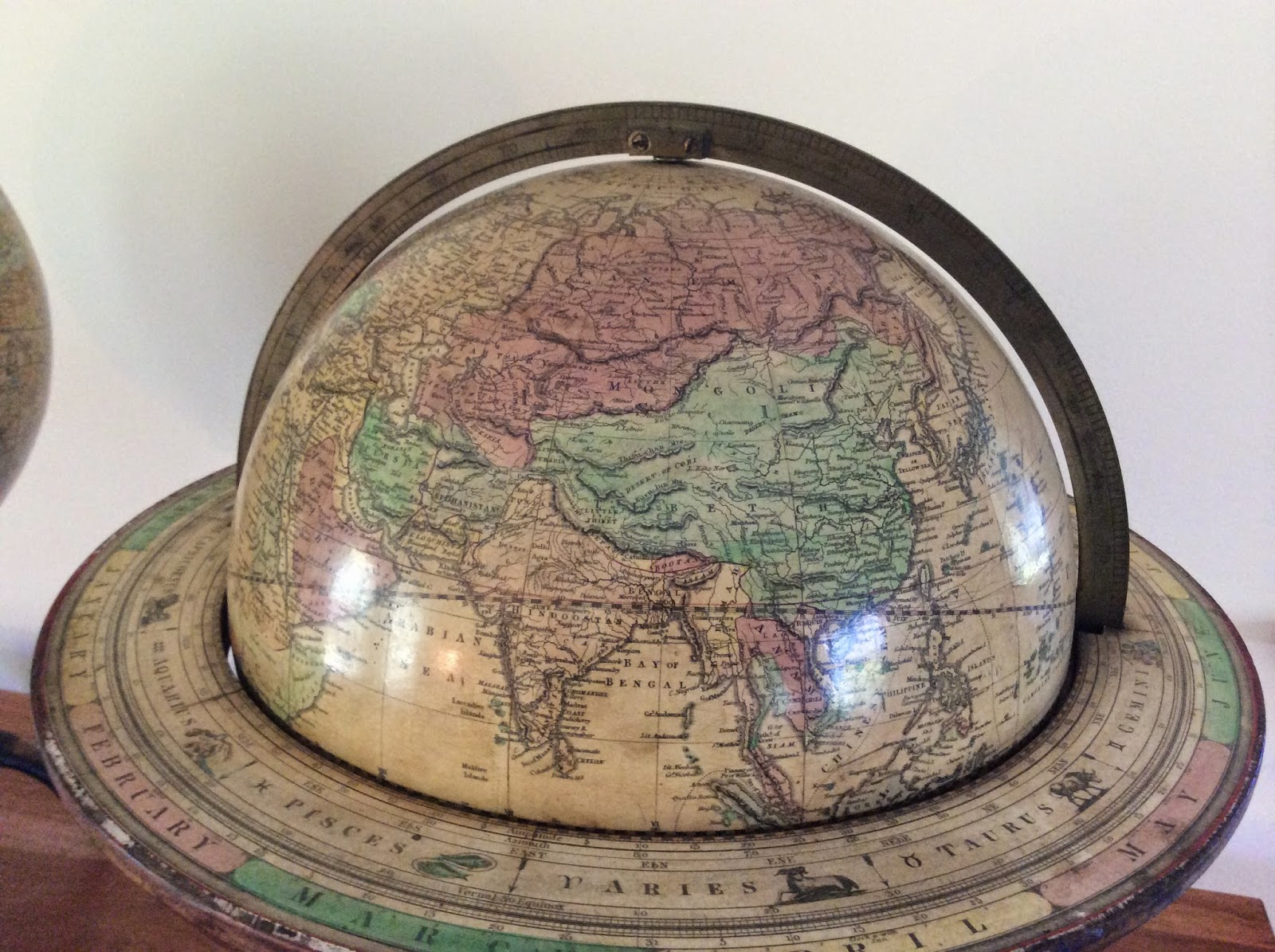First what is so bad about the sun? Well the ink these globes were printed with especially red is very sensitive to fading from sun exposure, many antique globes in fact the VAST majority of antique globes have already suffered substantial fading from sun exposure probably when they were new.
I want to share an example of what I'm talking about:
Below I have 4 pictures both are Joslin globes only a few years apart in age, but what should be striking is the difference in coloring. On the 1891 example you see a very typical coloring of muted reds and greens, these shades should look familiar to anyone studying globes from this time period, a mellow, warm surface. Not unattractive in the least. What a lot of people never realize is that the globe makers original intent was much bolder, much brighter, and more vivid. This other Joslin 1888 shows these bold colors the same bold colors that were at one time present on the other globe.
 |
| 1891Joslin color fade |
 |
| 1888 Joslin colors intact |
 |
| Muted Australia color |
 |
| Strong Australia color |
So what happened? In simple terms, the sun happened, the 1888 Joslin was fortunate to spend it's early years, in a darker room than the 1891 example, or it was displayed for a far shorter period of time before being stored away. Both of these globes probably spent 100 years in a closet to survive at all, but the 1888 Joslin just got to that dark closet a little earlier in it's life. This is a fairly dramatic example of the power of the sun. So as antiques sun protection is all that much more important, especially to preserve the sharp coloring still remaining.
I keep all of my globes in a fairly low light environment, and I have installed window film on all of the windows in the rooms that the globes reside, as well as blinds. Is this all necessary? Well that depends on how serious a collector you plan on becoming. If owning a few globes that are in average condition, and displaying them as decor in your home is your goal then no you probably don't need this. If you actively seek the best globes you can afford and decorate your home around your collection, then yes sun protection is necessary, the proof is in the pictures.
I want to be clear that the vast majority of globes encountered from the 19th century have already witnessed the effects of the sun, and in fact the effect we observe today on such globes as the Joslin 1891 are not at all displeasing. On the contrary that particular globe and ones like it show muted color, and a soft hand of time that we have come to expect from these globes, it is only when we see what they started out as that we realize what the manufacturer intended.
I want to share one more example of preservation you will encounter more frequently. Isothermal lines, those red and blue lines showing areas of equal temperature in summer and winter, were popular on many globes from the beginning of the 20th century onward. Sun fade to the ink in these lines especially the red lines is almost a given, but I want to show an example of a globe with the lines still intact. These lines are usually some of the first things to be lost to fading, fantastic to see when they are present.
I want to be clear that the vast majority of globes encountered from the 19th century have already witnessed the effects of the sun, and in fact the effect we observe today on such globes as the Joslin 1891 are not at all displeasing. On the contrary that particular globe and ones like it show muted color, and a soft hand of time that we have come to expect from these globes, it is only when we see what they started out as that we realize what the manufacturer intended.
I want to share one more example of preservation you will encounter more frequently. Isothermal lines, those red and blue lines showing areas of equal temperature in summer and winter, were popular on many globes from the beginning of the 20th century onward. Sun fade to the ink in these lines especially the red lines is almost a given, but I want to show an example of a globe with the lines still intact. These lines are usually some of the first things to be lost to fading, fantastic to see when they are present.
 |
| Both red and blue isothermal lines intact |
A final footnote, sun protection becomes even more important the further south you are ( or north for our Australian friends) you've got your work cut out for you if your collecting globes in Key West! Actually if you are collecting globes in Key West, please invite me down to see your collection this winter.......
* Actually all globe collectors are map collectors, but not all map collectors are globe collectors!
No comments:
Post a Comment